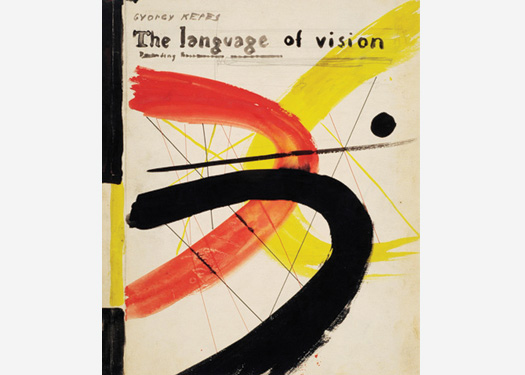
György Kepes, "Diagram," cut paper and ink
This collection is a record of the immensely productive life of György Kepes. Currently available for purchase from the rare book firm Ars Libri, it includes crates of notes and manuscripts from his books — many of them lavishly illustrated with original drawings and diagrams; typescripts of lectures; memoranda; correspondence; diaries, and agendas; heavily annotated sketchbooks crammed with compositions for paintings and stained glass; photographs, as well as pictures acquired for publication purposes and incidental examples of his own drawings, watercolors and other works of art. Included are files for his books, The Language of Vision, The New Landscape in Art and Science, and the seven-volume Vision and Value Series. There is also extensive material for his unfinished project, The Light Book, which absorbed him for nearly the whole of his working life, beginning with notes and sketches from 1937, partly in Hungarian, partly in English.
György Kepes was born October 4, 1906, in Hungary and attended the Royal Academy of Fine Arts in Budapest, where he studied painting under the tutelage of impressionist Istvan Csok. In 1930, Kepes moved to Berlin to pursue work in publication design, exhibition design and stage design. It was here that he completed this first dust-jacket, a cover for the book Film als Kunst by Rudolf Arnheim, it was also in Berlin that he first meet László Moholy-Nagy and an influential friendship began. In 1936 Moholy-Nagy relocated his studio to London, with Kepes in tow.
In London, Kepes meet his soon-to-be wife, Juliet Appleby, who later became a well-known illustrator and author of children's books. The following year Moholy was offered a job in Chicago as director of the then newly founded Institute of Design, also known as the New Bauhaus. Kepes followed and procured himself the position as head of the department of Light and Color. In 1942, courted by Russian architect Serge Chermayeff, Kepes moved to Brooklyn College, where his students included Saul Bass.
In 1944 Kepes published his first book Language of Vision, which became known the world over and widely used as a textbook for collage curricula. It was also in this year that Kepes accepted an invitation to start a program at MIT. This program was centered on visual design and later morphed into the Center for Advanced Visual Studies.
Through the ’60s Kepes edited Vision and Value (1965–1972), a set of seven anthologies, which included essays from the most prominent artists, designers, architects and scientists of the time. In addition, Kepes wrote the books Language of Vision; Graphic Forms: The Arts as Related to the Book; The New Landscape in Art and Science, among others.
György Kepes died on December 29, 2001. In addition to his contributions to academia, he was also was a prolific painter and photographer.
Additional special features of interest in the archive include original gouache designs by Kepes for the cover of The Language of Vision, early correspondence with his publishers, the guestbook of the Kepes summer house in Wellfleet, and letters from Laszlo Moholy-Nagy, Walter Gropius, Richard Neutra, Fernand Léger, Piet Mondrian, Josef Albers, Mark Rothko, John Cage, Hilla Rebay, Edward Weston, Buckminster Fuller, Norbert Wiener, I.A. Richards and Rudolf Arnheim.
More Ars Libri collections here.

